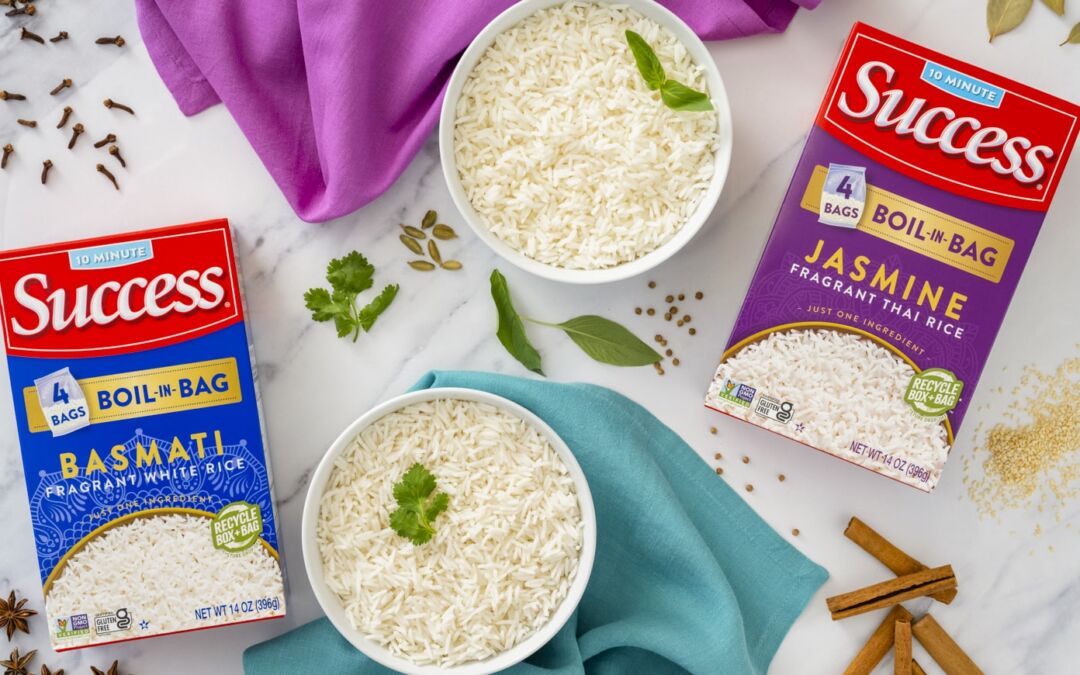Rice is rice, right? Wrong! Long or short grain, fluffy or sticky, fragrant or gentle enough to soak up a world of flavors, different types of rice each offer something unique to enjoy. So, what’s the difference between basmati and jasmine rice? Read on to learn more about two of the world’s most popular rice varieties, including what sets them apart and how best to cook them, pair them, and make the most of each and every grain.
Basmati vs Jasmine Rice
- Native to the Indian subcontinent, basmati rice has been grown in several countries — including India, Pakistan, Sri Lanka and Bangladesh — for centuries. Today, some varieties of basmati rice are also grown in the United States. Jasmine rice, on the other hand, is predominantly grown in South-East Asia, specifically in Thailand, Laos, Cambodia and Vietnam.
- Basmati and jasmine rice are both categorized as long-grain rice varieties. They are slender and cook up light and separate, unlike short-grain rice which tends to clump together when cooked. The key difference between these types of rice is that jasmine rice is slightly softer than basmati, and holds more moisture. Due to this fact, it’s best used in dishes like fried rice and stir-fries.
- Though basmati and jasmine rice are both undeniably delicious, each variety brings something unique to a final dish. Nutty and aromatic, basmati has a less pronounced flavor when cooked. Jasmine rice is slightly sweet and floral, and can easily heighten any dish.
- When it comes to texture, basmati and jasmine rice are quite different. Dry and light, basmati holds its shape when cooked, and its grains remain separate. Slightly chewy and soft, jasmine rice absorbs more flavor when cooked.
- Side by side, it’s easy to tell the different between the aroma of basmati and jasmine rice. The former, has a distinctively delicate, nutty smell. The latter, is more aromatic with a subtle floral perfume.
Basmati Rice vs. Jasmine Rice in Cooking
When it comes to cooking basmati and jasmine rice, knowing the best method to follow will lead to the best results.
It’s best to rinse basmati rice, then soak it, before cooking. This helps to remove excess starch, leaving you with more separate grains when the rice is cooked. To begin, simply place the rice in a bowl, then fill the bowl with fresh water and swirl the rice around. Drain the water, and repeat the process until the water is clear. Allow the rice to soak for 30 minutes before cooking it. Generally, the best ratio is 1 1/2 cups of water for every 1 cup of basmati rice.
If these seems like too much work, or you’re running late with dinner prep, Success® boil-in-bag basmati rice is a handy option that doesn’t require rinsing or soaking and is ready to enjoy in just 10 minutes. Use it in curries and appetizers, breakfast bowls, soups and even desserts!
For jasmine rice, skip the soaking and simply rinse the grains in cold water. To ensure you end up with fluffy rice, use slightly less water than you would for other rice varieties. Jasmine rice cooks best when you use 1 1/4 cups of water for every 1 cup of rice. On busy weeknights, try Success® boil-in-bag jasmine rice for optimal results — in mere minutes!
Ideal in Asian-inspired dishes, jasmine rice is delicious in poke bowls, fried rice and Thai-style wraps. Having said that, its tempting texture and light flavor are also exceptional in dishes as varied as paella and frozen rice pudding!
For anyone wondering, these two varieties of rice can be used almost interchangeably. They can also be used anywhere you might commonly use white or brown rice!
A World of Possibilities!
Delicious, versatile, inexpensive and easy to make, it’s no surprise that basmati and jasmine rice rank among the world’s most popular foods. At breakfast or snack time, dinner or dessert, these two varieties of rice are easy to prep and play nicely with just about any food you can think of! Even when you cook more than you need, there are myriad ways to use up the leftovers, meaning you never have to waste a single grain.
Get inspired with these tasty, tempting street food recipes from around the globe, and cook up a feast using these two mighty grains.

